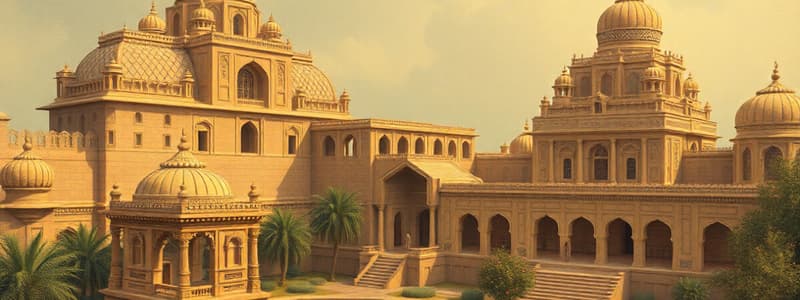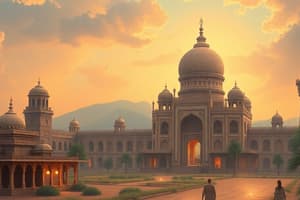Podcast
Questions and Answers
Why was Cunningham initially confused about the significance of Harappan artifacts?
Why was Cunningham initially confused about the significance of Harappan artifacts?
Cunningham primarily focused on accounts from Chinese Buddhist pilgrims and missed the significance of Harappan artifacts not mentioned in those accounts.
What key realization came about due to the discoveries at Harappa and Mohenjodaro in the early 20th century?
What key realization came about due to the discoveries at Harappa and Mohenjodaro in the early 20th century?
The discoveries led to the realization that Harappa and Mohenjodaro were part of a single, extensive civilization.
How did Mortimer Wheeler's approach to archeology differ from previous methods, and what did it reveal about the Harappan civilization?
How did Mortimer Wheeler's approach to archeology differ from previous methods, and what did it reveal about the Harappan civilization?
Wheeler brought a military precision to archeology, which helped to recognize that the Harappan civilization was older than previously thought.
Besides wheat and barley, name three other crops cultivated by the Harappans, as indicated by plant remains found at various sites.
Besides wheat and barley, name three other crops cultivated by the Harappans, as indicated by plant remains found at various sites.
Besides bones from domesticated animals, what other type of animal bones were found at Harappan sites, suggesting a supplement to their diet?
Besides bones from domesticated animals, what other type of animal bones were found at Harappan sites, suggesting a supplement to their diet?
How do terracotta models found in Cholistan and Banawali provide insights into Harappan agricultural technology?
How do terracotta models found in Cholistan and Banawali provide insights into Harappan agricultural technology?
Describe the typical layout of a Harappan city like Mohenjodaro, mentioning the two main sections and their respective functions.
Describe the typical layout of a Harappan city like Mohenjodaro, mentioning the two main sections and their respective functions.
Explain how the Harappan drainage system was constructed and maintained, emphasizing its effectiveness in urban sanitation.
Explain how the Harappan drainage system was constructed and maintained, emphasizing its effectiveness in urban sanitation.
What are some ways archaeologists study burials at Harappan sites to understand social differences?
What are some ways archaeologists study burials at Harappan sites to understand social differences?
List three materials commonly used by Harappans in craft production, indicating the diversity of resources utilized for their crafts.
List three materials commonly used by Harappans in craft production, indicating the diversity of resources utilized for their crafts.
Flashcards
Mortimer Wheeler
Mortimer Wheeler
Director General of the ASI who brought in military precision to archeology and recognized the age of the Harappa civilization.
Urban Centers
Urban Centers
The most unique feature of the Harappan civilization.
Domesticated Animal Bones
Domesticated Animal Bones
Include those of cattle, sheep, goat, buffalo, and pig; used for agricultural purposes.
Bull
Bull
Signup and view all the flashcards
Shortughai
Shortughai
Signup and view all the flashcards
Citadel and Lower Town
Citadel and Lower Town
Signup and view all the flashcards
Drainage Systems
Drainage Systems
Signup and view all the flashcards
The Great Bath
The Great Bath
Signup and view all the flashcards
Bead Making
Bead Making
Signup and view all the flashcards
Harappan Seals
Harappan Seals
Signup and view all the flashcards
Study Notes
- Indian archeology's story started during the 19th century
- Cunningham used the accounts of Chinese Buddhist pilgrims to try and find early settlements, which led to confusion.
- Cunningham overlooked the significance of Harappan artifacts, as they were not part of the pilgrims' itineraries.
- A better grasp of the civilization only started in the 20th century
- Daya Ram Sahni began excavations at Harappa at this time
- Rakhal Das Banerji located similar seals at Mohenjodaro
- These discoveries showed that the locations were part of one civilization
- Mortimer Wheeler, as the new director general of the ASI, brought a military-like precision to archeology.
- Wheeler realized that the Harappa civilization was older than initially assumed.
- The Harappan Civilization location was in Punjab and Sindh.
- The Harappan civilization is also known as the Indus Valley Civilization.
- The urban centers' development is the most unique aspect of the Harappan civilization.
Subsistence Strategies
- The Harappan civilization used various subsistence strategies.
- Plant remain studies show the Harappans grew wheat, barley, lentil, chickpea, and sesame.
- Gujarat sites show the presence of millets.
- Rice was not commonly used.
- Harappan sites contained animal bones of cattle, sheep, goat, buffalo, and pig.
- These animals were domesticated for agricultural work
- Bones of wild animals such as boar, deer, and gharial have been discovered
- The Harappans likely hunted these wild animals for meat.
Agricultural Technologies
- The Harappan civilization needed agricultural technologies to support the population.
- Seals and terracotta sculptures show that bulls were used for plowing
- Cholistan and Banawali have terracotta plough models.
- Shortughai in Afghanistan has evidence of irrigation..
- Most Harappan sites are in semi-arid areas, so irrigation was likely needed for agriculture.
- Wells and canals provided irrigation
- Shortughai has canal traces, but Punjab and Sindh do not.
- Harappans possibly used well water for irrigation.
- Dholavira water reservoirs may have been for agricultural water storage.
Mohenjodaro - A Planned Urban Centre
- Mohenjodaro stands out as the most well-known Harappan site.
- The settlement has two parts: the citadel and the lower town.
- The citadel was smaller but higher, while the lower town was bigger but lower.
- The structures on the citadel likely served public functions.
- The lower town served as the residential area
- Both parts of the city were surrounded by walls.
- The settlement had a planned layout before construction.
Drainage Systems
- The Harappan civilization was known for its advanced drainage system
- Drains used brick and mortar
- The grid pattern had drains from individual houses that connected to larger drains, which then emptied into a main drain.
- Stone slabs covered the drains for cleaning access.
- The drainage system was well-maintained to keep the city clean.
The Citadel
- The Citadel had multiple public structures
- The Great Bath was a large rectangular tank in a courtyard
- It could have been for religious or ceremonial uses.
- The Warehouse was a large building, probably for grain storage.
The Lower Town
- The Lower Town was the residential area of the city.
- Houses typically had one or two stories
- They were made of brick and had a courtyard
- Houses included private wells and bathrooms.
- Some houses were large with multiple rooms.
Social Differences
- Archeology identifies social differences in different ways
- Studying burials is one way to identify these differences
- Harappan burial sites were simple pits.
- Some burials had pottery and ornaments, which may be indicators of social differences.
- Studying artifacts is another way to identify social differences.
- The wealthy likely used jewelry and precious metals
- The Great Bath is the most elaborate structure found at Harappan sites.
Craft Production
- The Harappan civilization was known for its craft production.
- Bead making, shell cutting, metalworking, and seal making were essential crafts
- Chanhudaro was the center for craft production
- Harappans used stone, shell, and metal for crafts.
- Nageshwar and Balakot were shell production centers.
- Shortughai was near precious stone sources.
Identifying Centers of Production
- Archeologists identify production centers by looking for raw materials, tools, and unfinished items.
- They also look for workshops and storage Evidence of workshops and storage facilities..
- Waste material is a strong indicator of craft production.
Strategies for Procuring Materials
- The Harappans used multiple strategies for getting materials
- They created settlements close to raw material sources
- They had expeditions to get materials from far away.
- They also traded with other cultures for materials.
Contact with Distant Lands
- The Harappans had contact with Oman, Mesopotamia, and the Persian Gulf.
- Harappan seals and artifacts were discovered in these areas.
- Mesopotamian texts mention Meluha, which is believed to be the Harappan region.
Seals, Script, Weights
- Seals and script were used by the Harappan civilization
- Harappan seals were typically made of steatite
- They feature a rectangular shape, animal motifs, and script..
- The Harappan script has not been deciphered.
- Harappan weights were stone cubes
- Weights were precise and used for trade.
Ancient Authority
- There is no real evidence of a central authority in the Harappan civilization
- Some archeologists think there were regional leaders instead of one ruler
- Other archeologists think there was one state, but it was not very centralized
- Uniformity in artifacts and settlements suggests some central planning and control
- Some archeologists believe that the Harappan civilization was ruled by priests.
The End of the Civilization
- By 1800 BCE, most of the Harappan civilization was gone
- Contributing factors to its decline may have included climate change, deforestation, and flooding
- An invasion by outsiders is also another theory
- By 1800 BCE, people abandoned Harappan cities
- People relocated to smaller rural settlements
- The civilization did not disappear, but declined
- Some Harappan traditions continued for centuries.
Studying That Suits You
Use AI to generate personalized quizzes and flashcards to suit your learning preferences.




